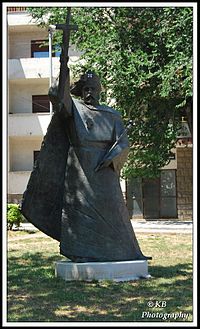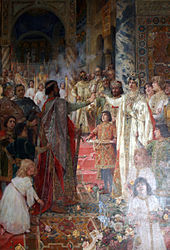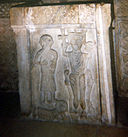- Demetrius Zvonimir of Croatia
-
For other people of the same name, see Zvonimir (name).
Demetrius Zvonimir King of Croatia and Dalmatia[1] 
Romantic portrait by Kristian Kreković King of Croatia Reign 1076-1089 Coronation 8 October 1076 Predecessor Petar Krešimir IV Successor Stephen II Ban of Slavonia Reign c. 1064–1075 Predecessor Gojko Sucessor Peter[2] Spouse Helen II of Croatia Issue Radovan
ClaudiaRoyal House House of Svetoslavić (?) Father Stjepan Svetoslavić (?) Died 20 April 1089[3]
Knin, Kingdom of CroatiaBurial Church of St. Mary, Knin, Croatia Religion Roman Catholic Demetrius Zvonimir (Croatian: Dmitar Zvonimir, Latin: Demetrius Sunimirio, pronounced [dmitar zʋɔnimir]; ? – 20 April 1089i[›]) was King of Croatia from 8 October 1076 until his death. He also ruled as Ban of Slavonia (1064–1074), and was named Duke of Croatia in around 1075. His native name was Zvonimir, while the name Demetrius (Dmitar in Croatian) was adopted at his coronation.
He began as a Ban of Slavonia in the service of King Stephen I. Afterwards, he was appointed Duke of Croatia by his predecessor Peter Krešimir IV, who later declared him as his heir. In 1076, Dmitar Zvonimir succeeded to the Croatian throne.[4] His reign is characterized as relatively peaceful; with no extensive war campaigns but with development in the fields of economy and culture. He was the last native king who exerted any real power over the entire Croatian state, which he inherited at its height and ruled it from the city of Knin.
Contents
Biography
Although his exact origin is a speculation, a theory suggests that Demetrius was most likely a descendant of Svetoslav Suronja and the younger cousin of Peter Krešimir IV. On another note, it is believed that he had no real connection with the Croatian royal family of Trpimirović but was designated by Krešimir IV and later elected (confirmed) by an assembly of nobles (bans).[6][7] The only few things that are truly known about his background assert that he had a magister (a Latin phrase for "teacher") named Šestak, who also contributed in the construction of monasteries around Croatia, that his uncle (brother of mother) was Streza,[8] and that his family owned some estates near Biograd.
Banate of Slavonia and Croatia
From about 1064, during the reign of Peter Krešimir IV (his relative through the Orseoli of Venice), Demetrius Zvonimir ruled in Slavonia, specifically the land between the rivers Drava and Sava, with the title of ban.[9]
The neighbouring Holy Roman Empire invaded Croatia in 1067 by sending the Carantanian army to occupy the northern Banate. This was probably a result of Zvonimir's close ties with Hungary, who was also in a war with the empire at the time. Since the Croatian king was preoccupied with the mutiny in Dalmatia that was in progress due to the prohibition of Slavic liturgy[7], Demetrius was compelled to seek prevention on the court of king Salamon instead. After they jointly repelled the enemy from Croatia, Ban Zvonimir sent gifts to him as a sign of gratitude.[10]
At the beginning of 1075, Peter Krešimir IV named Demetrius Zvonimir "by the mercy of God Duke of Dalmatian Croatia". This title made him not only the ruler of northern Dalmatia, but also the chief advisor of the king and his heir. Peter Krešimir IV soon died after he got imprisoned by the Normans and Demetrius Zvonimir succeeded him.[citation needed]Somewhere during the middle of 1075, Zvonimir made an agreement with the coastal cities of Dalmatia that were originally lost to the Normans and managed to reunite them with the state again.[11]
Reign as king
Demetrius Zvonimir was crowned on 8 October 1076[4][12] at Solin in the Basilica of Saint Peter and Moses (known today as Hollow Church) by a representative of Pope Gregory VII.[13][14] After the pope's deputies crowned him for the king of the Croatia, Demetrius Zvonimir in 1076 donated the city of Vrana and Benedictine monastery of St. Gregory, as a sign of loyalty to Pope Gregory VII. He is known for building a three-naved basilica near Knin and the city is today nicknamed "Zvonimir's city". He continued the expansive and pro-Roman policies of his predecessor, maintaining close alliance with the papacy. He instituted the Gregorian reform and took up many domestic reforms, like the abolishment of slavery in his kingdom.
He was a part of a minor conflict with the Holy Roman Empire, specifically one of the dukes from Istria who was preparing for an attack on Croatia, in which the pope interferred in 1079 and settled the fray on behalf of Zvonimir.[11] Demetrius Zvonimir also took a hard line against the Byzantine Empire, but, unlike Petar Krešimir IV, he was also an ally of the Normans, with whom he joined in wars against Byzantium. When Robert Guiscard, Duke of Apulia, invaded the western Balkan provinces of the empire in 1084, Zvonimir sent troops to his aid.[15]
Accounts on Zvonimir's death
There are several versions of Zvonimir's death. The most commonly accepted one, asserted by Thomas the Archdeacon, asserts that Demetrius died of natural causes.[16][17] Another account, from the Presbyter of Doclea, says that on 20 April 1089, desiring to heal the East-West Schism Pope Urban II asked Zvonimir, his strongest Balkan ally, to come to the military aid of Alexios I Komnenos against the Seljuks. Zvonimir convened the Sabor at Kosovo Polje near Knin that year to mobilize the army on behalf of the pope and the emperor, but the nobility refused him and a rebellion erupted, leading to Zvonimir's assassination at the hands of his own soldiers.[3] His death marked the collapse of Croatian royal power. The myth of the "Curse of King Zvonimir" is based on the legend of his assassination.[18] He was most likely buried in the church of St. Mary in his capital Knin,[11] while his remains were transferred to Solin some time after. An epitaph to his grave was recorded (although, assumed as a forgery from centuries later):
“ Who could refrain the people, not to sigh, when they watch this grave, truly worthy of sorrow? Because in this darkness a bright star rests, with a sublime ancestry. How it oddly numbs! Since its barbarous death can only be with begging interpreted, with dark crime of wicked folk, where their fury relents until the heart eases and with murder they take down the king, very healthy, with much power, the pious Zvonimir, distinctly fair and honest, who was their shield against enemies, used to crush the rival doors, mourn, champions, already a leader plies, old and young of Croatian land, because what was first godly of the kingdom and also honour and glory, is now in ruins.
” Succession
Demetrius Zvonimir was married to his distant relative Jelena, the sister of Ladislaus I of Hungary.[19] Through Helen, he was connected to the royal families of not only Hungary, but also Poland, Denmark, Bulgaria, and Byzantium. She bore him a son, Radovan, who predeceased him, and a daughter, Claudia, who, being married to the vojvoda of Lapcani Lika, was ineligible for the throne. He was succeeded by Stephen II, last of the House of Trpimirović, but he died in 1091, at which point Ladislaus became the best candidate for the succession.
Marriage and children
c. 1063: Helen, daughter of King Béla I of Hungary
- Radovan (c. 1065 – 1083/1089), designated heir, but is dead before 1089
- Claudia (? – ?), wife of Voivode of Lapčani Lika
Ancestors
Ancestors of Demetrius Zvonimir of CroatiaLegacy
 Monument in Knin
Monument in Knin
The culturally and historically significant Baška tablet was inscribed shortly after his death and contains references to him and a number of his nobles of the 11th century. For the first time, Baška tablet mentions the title of Croatian Kings in Croatian: kral (kralj in modern Croatian).[20]
"Zvonimir" is today a traditional and quite common Croatian name meaning "sound, chime" (zvoni) and "peace, prestige" (mir),[21] King Zvonimir being the first recorded bearer of the name.
The Grand Order of King Dmitar Zvonimir, which is awarded to high ranking officials is named after him.
See also
- Crown of Zvonimir
- Medal of the Crown of King Zvonimir
- Hollow Church
References
- ^ Arhinet - "rex Chrobatorum et Dalmatinorum, rex (tocius) Chroacie atque Dalmacie, Chroatorum atque Dalmatinorum rex"
- ^ Hupi - Popis Hrvatskih banova
- ^ a b Death of King Zvonimir - problem, sources and interpretation
- ^ a b Dominik Mandić, Rasprave i prilozi iz stare hrvatske povijesti, Institute of Croatian history, Rome, 1963., page 315., 438.
- ^ http://arhinet.arhiv.hr/_DigitalniArhiv/Monumenta/HR-HDA-876-10.htm
- ^ http://www.hercegbosna.org/STARO/ostalo/pabirci.html
- ^ a b Neven Budak, Prva stoljeca Hrvatske, Hrvatska sveučilišna naklada, Zagreb 1994.
- ^ Znameniti i zaslužni Hrvati: te pomena vrijedna lica u hrvatskoj povijesti od 925-1925, str. X, Odbor za izdanje knjige "Zaslužni i znamenti Hrvati 925-1925.", Emilije Laszowski, Zagreb 1925.
- ^ http://arhinet.arhiv.hr/_DigitalniArhiv/Monumenta/HR-HDA-876-5.htm
- ^ Ferdo Šišić, Povijest Hrvata u vrijeme narodnih vladara, 1925, Zagreb ISBN 86-401-0080-2
- ^ a b c Ferdo Šišić, Povijest Hrvata; pregled povijesti hrvatskog naroda 600. - 1918., Zagreb ISBN 953-214-197-9
- ^ http://crohis.com/knjige/Sisic%20-%20pregled/18.%20Slavac%20-%20Dmitar%20Zvonimir.PDF
- ^ Demetrius, Duke of Croatia and Dalmatia, after receiving the royal title by a legate of Gregory VII (1073-1085) promises to grant St. Peter’s pence
- ^ Tomislav Raukar: "Hrvatsko srednjovjekovlje", Školska knjiga, Zagreb, 1997., ISBN 953-0-30703-9, str. 49
- ^ http://crohis.com/knjige/horvat-povijest/4.hr-vlad.PDF
- ^ Historia Salonitana
- ^ Marcus Tanner, Croatia - a nation forged in war, Yale University Press, New Haven, 1997 ISBN 0-300-06933-2
- ^ Damir K., The Šubići and the Good King Zvonimir. A Contribution to the Research on Use of Legends as a Means of Politics of Croatian Aristocratic Families, Zagreb 2000
- ^ Trpimir Macan, Povijest hrvatskoga naroda, Zagreb, 1992.
- ^ Baska tablet - Dr. sc. Mateo Zagar
- ^ http://www.behindthename.com/name/zvonimir
Notes
^ i: This is the date generally given when it comes to the theory of his assassination, as it was reported by many.
External links
- (Croatian) August Šenoa - In the memorial of 800th anniversary of Zvonimir's coronation
- Zvonimir on Royal Croatia
Demetrius Zvonimir of CroatiaDied: 20 April 1089Regnal titles Preceded by
GojkoBan of Croatia
c.1065–1075Succeeded by
PetarPreceded by
Peter Krešimir IVKing of Croatia
1076–1089Succeeded by
Stephen IIHouse of Trpimirović Trpimir I (845–864) · Zdeslav (878–879) · Muncimir (892–910) · Tomislav (910–928) · Trpimir II (928–935) · Krešimir I (935–945) · Miroslav (945–949) · Michael Krešimir II (949–969) · Stephen Držislav (969–997) · Svetoslav Suronja (997–1000) · Krešimir III (1000– c. 1030) and Gojslav (1000–c. 1020) · Stephen I (c. 1030–1058) · Peter Krešimir IV (1058–1074) · Demetrius Zvonimir (1075–1089) · Stephen II (1089–1091)
Monarchs of Croatia House of Trpimirović (Croatia) Tomislav (910–928) · Trpimir II (928–935) · Krešimir I (935–945) · Miroslav (945–949) · Michael Krešimir II (949–969) · Stephen Držislav (969–997) · Svetoslav Suronja (997–1000) · Krešimir III (1000– c. 1030) with Gojslav (1000–c. 1020) · Stephen I (c. 1030–1058) · Peter Krešimir IV (1058–1074) · Demetrius Zvonimir (1075–1089) · Stephen II (1089–1091)House of Árpád (Hungary) Ladislaus I (1091–1093)House of Svačić (Croatia) Petar Svačić (1093–1097)House of Árpád (Hungary) Coloman (1097–1116) • Stephen III (1116–1131) • Béla I (1131–1141) • Géza (1141–1162) • Stephen IV (1162–1172) • Ladislaus I (1162–1163) • Stephen V (1163) • Stephen IV (1163–1172) • Béla II (1172–1196) • Emeric (1196–1204) • Ladislaus II (1204–1205) • Andrew I (1205–1235) • Béla III (1235–1270) • Stephen VI (1270–1272) • Ladislaus III (1272–1290)House of Anjou (Naples) Charles Martel (1290–1295)House of Árpád (Hungary) Andrew II (1295–1301)House of Anjou (Naples) Charles I Robert (1301–1342) • Louis I (1342–1382) • Mary (1382–1385) • Charles II (1385–1386) • Mary (1386–1395)House of Luxemburg (Bohemia) Sigismund (1387–1437)House of Savoy (Savoy) Tomislav II (1941–1943)Categories:- Trpimirović
- 11th-century births
- 1089 deaths
- Kings of Croatia
- Bans of Croatia
- Croatian nobility
- Medieval Croatia
- 11th-century rulers in Europe
- Roman Catholic monarchs
Wikimedia Foundation. 2010.




